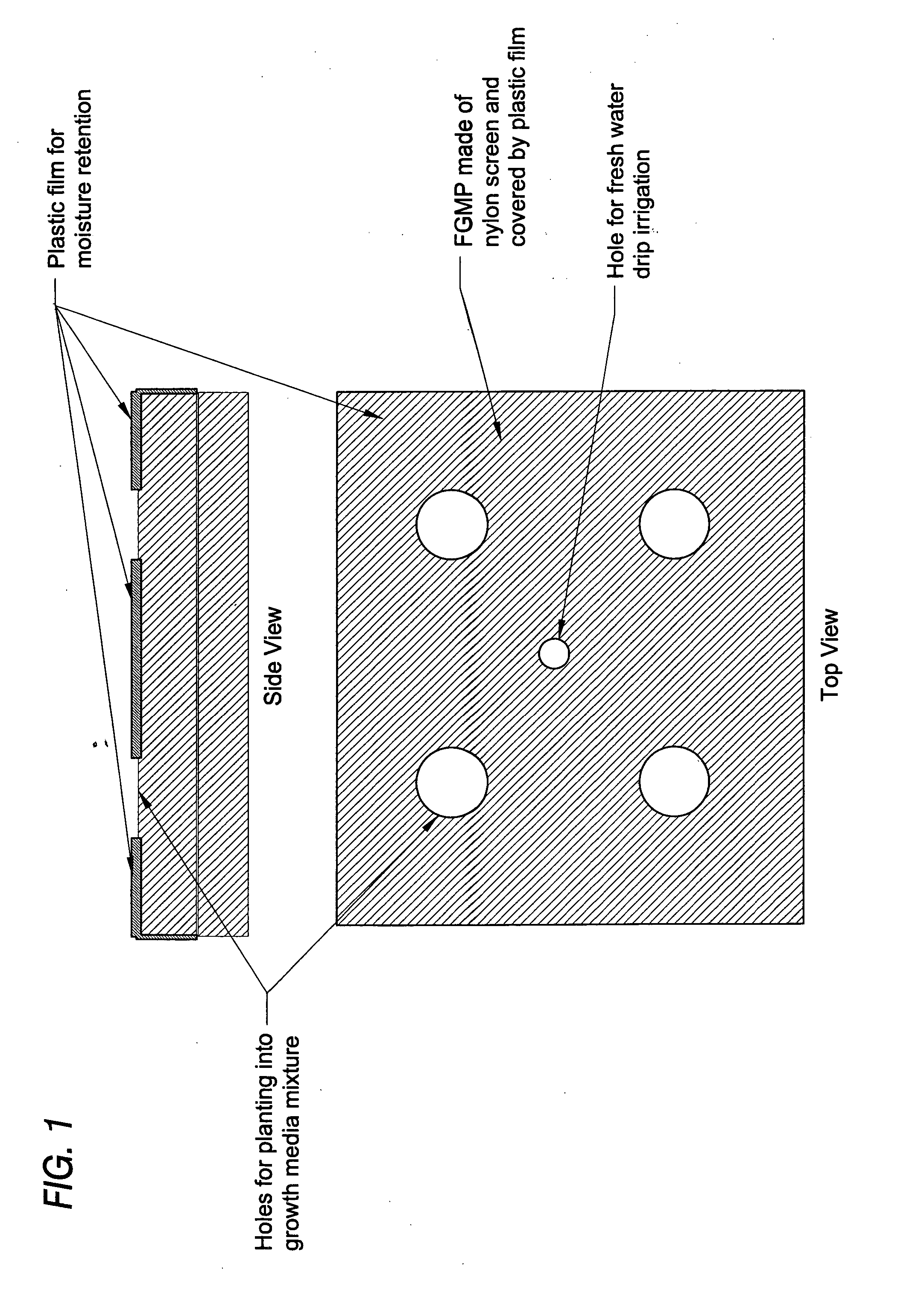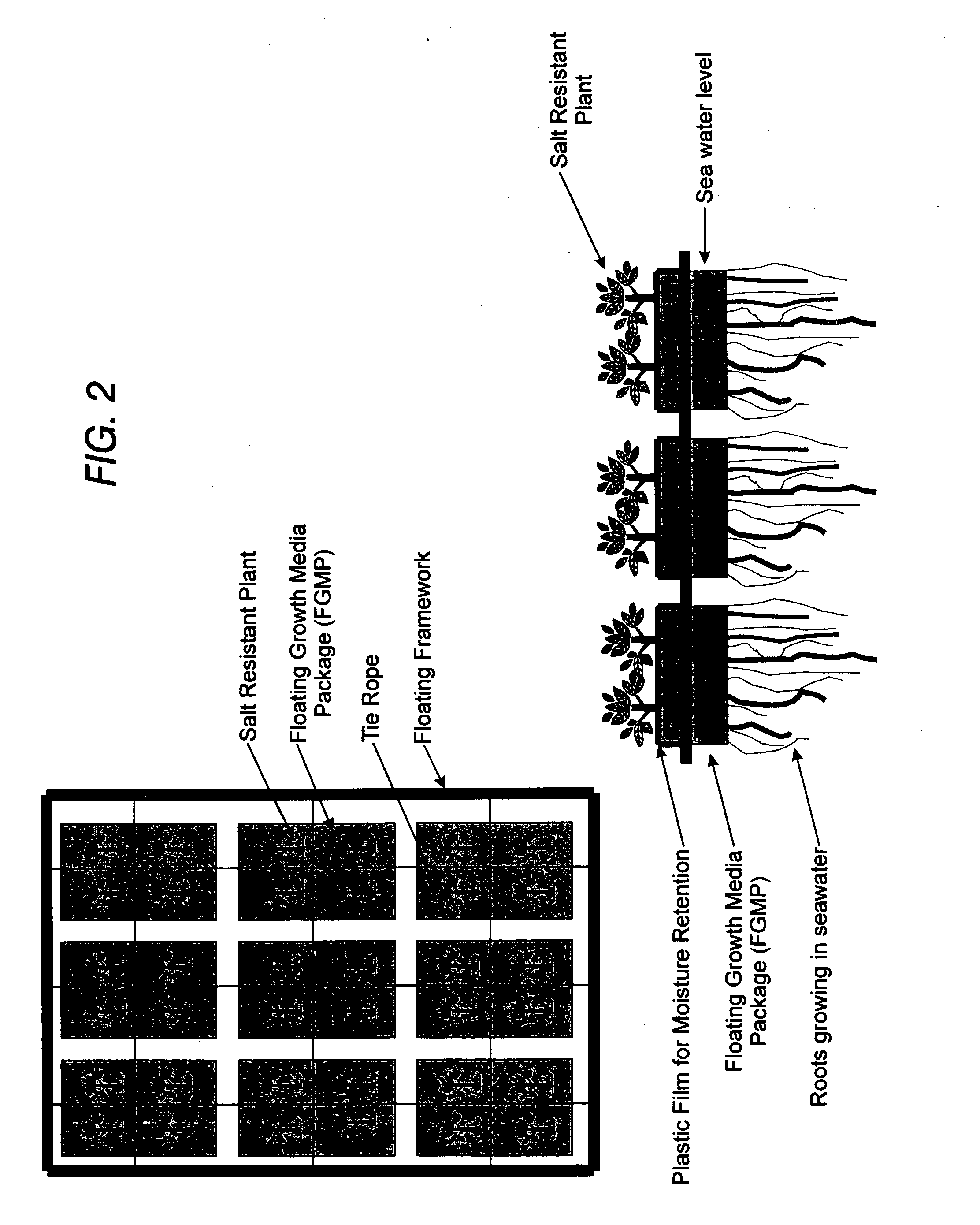Floating plant cultivation platform and method for growing terrestrial plants in saline water of various salinities for multiple purposes
a technology of floating plant cultivation and saline water, which is applied in the field of plant agriculture, can solve the problems of shortening the availability of arable land and fresh water, limited arable land, and inability to grow terrestrial plants, and achieves the effects of high mobility, convenient disassembly and setting, and efficient administration
- Summary
- Abstract
- Description
- Claims
- Application Information
AI Technical Summary
Benefits of technology
Problems solved by technology
Method used
Image
Examples
example 1
Example of Making the Sheet-style FSCP With Air Filled Bags for Buoyancy
[0122] In waters that are less calm, such as coastal waters or waters during storm conditions, a more flexible system can avoid the possibility of breakage problems of the rigid framework. Accordingly, an FSCP was prepared using inflated plastic pipes and polypropylene ground cover, using the following method. The method has the added advantages of ease of assembly and transport and low cost. A sheet-style FSCP was prepared which was composed of a single layer of polypropylene ground cover folded to form narrow long bags in certain intervals (e.g., 11 inches) along the extended platform. Each bag contained two plastic pipes supporting the platform. The air pipes were made by blowing air into polyethylene tubing and sealing both ends. The plant stem was supported in between the two air pipes to allow root growth between the spaces in the bag and extrusion through the Ground Cover. Each side of the platform was c...
example 2
Example of Making the Sheet-style FSCP Using PVC Pipe to Make a Rigid Structural Framework
[0123] Because akulikuli is a prostrate herb, a sheet-style platform system with a single layer of shade cloth / ground cover, covered on the top of the PVC pipe framework, was sufficient to support its growth on the water. The sheet-style platform was made as described in the above example, except that structural framework made of a PVC pipe was used. The framework was assembled by joining two 5 feet and two 10 feet long PVC pipes (1.5 inch in diameter) in a standard method. Short pieces of PVC pipe (1.5 inch in diameter), cut through one side, were used to facilitate connecting the shade cloth onto the PVC pipe. The shade cloth / ground cover was stretched as tight as possible, and tied to the PVC framework using 8-inch long nylon cables.
example 3
Preparation of a Floating Growth Medium Package (FGMP), and Testing of Various Growth Media Using the FGMPs
[0124] One standard procedure for growth of akulikuli or other plants on a floating seawater cultivation platform is as follows. A typical FGMP illustrated in FIG. 2 was made of a polypropylene (70% or 100%) shade cloth bag (3 feet long, 1.5 feet width and 5 inch thickness). Solid culture medium, such as Polylite Expanded Polystyrene (EPS) Flakes (polylite; Pacific Allied Products, Ltd., Kapolei, Hi.) was placed in the pillow-like bag. The filled bag was sealed using a sewing machine. For experimental purposes, a small size of FGMP was made in a cylindrical shape (1 foot in diameter and 5 inches in height) (shown in FIG. 5A, 5B, 5C, 6B, 9A, and 9B). Three media were tested: 1. A mixture of 1:1 peat moss and polylite; 2. A mixture of 1:1 perlite and polylite; and 3. Polylite alone. The FGMPs were planted with akulikuli, milo and naio, and allowed to grow for several months. Aft...
PUM
| Property | Measurement | Unit |
|---|---|---|
| length | aaaaa | aaaaa |
| diameter | aaaaa | aaaaa |
| diameter | aaaaa | aaaaa |
Abstract
Description
Claims
Application Information
 Login to View More
Login to View More - R&D
- Intellectual Property
- Life Sciences
- Materials
- Tech Scout
- Unparalleled Data Quality
- Higher Quality Content
- 60% Fewer Hallucinations
Browse by: Latest US Patents, China's latest patents, Technical Efficacy Thesaurus, Application Domain, Technology Topic, Popular Technical Reports.
© 2025 PatSnap. All rights reserved.Legal|Privacy policy|Modern Slavery Act Transparency Statement|Sitemap|About US| Contact US: help@patsnap.com



